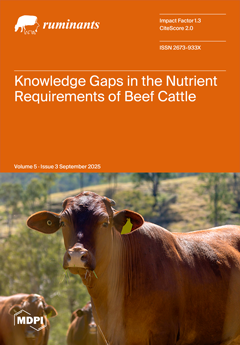This study aimed to evaluate the microbiological quality of colostrum on three dairy farms with different colostrum management hygiene practices and to compare it with the current colostrum quality guidelines. On farm A, colostrum was fed raw, while on farms B and C it was heat treated. On farms A and B, the feeding equipment was cleaned manually, while on farm C, an automated cleaning system was used. Samples were collected from the calf-feeding equipment and submitted for microbial culture: total plate count (TPC); total coliform count (TCC); and
E. coli, enterobacteria (ENTB), staphylococci (STAP), and lactic acid bacteria counts. In addition, pH, water activity (a
W), and Brix were analyzed. Colostrum quality was defined as follows: good quality (GQ)—TPC < 100,000, TCC < 10,000, STAP < 50,000 cfu/mL, and Brix ≥ 22%; excellent quality (EQ)—TPC < 20,000, TCC < 100, STAP < 5000 cfu/mL, and Brix ≥ 25%. Mean concentrations were as follows: TPC was 3.99 × 10
5 cfu/mL (min: 40.00, max: 1.32 × 10
7 cfu/mL); TCC was 1.17 × 10
4 cfu/mL (min: <detection limit, max: 6.37 × 10
5 cfu/mL); and STAP was 1.77 × 10
4 cfu/mL (min: <detection limit, max: 3.50 × 10
5 cfu/mL). Approximately 54% (GQ) and 32% (EQ) of samples met the defined criteria. Farm C consistently showed lower microbial counts across all culture types. Colostrum from farm B had lower TCC, LAB, and
E. coli counts than farm A but not TPC, STAP, and ENTB. These results showed that a considerable proportion of calves were fed colostrum with suboptimal quality, especially when less rigorous hygiene practices were implemented.
Full article





